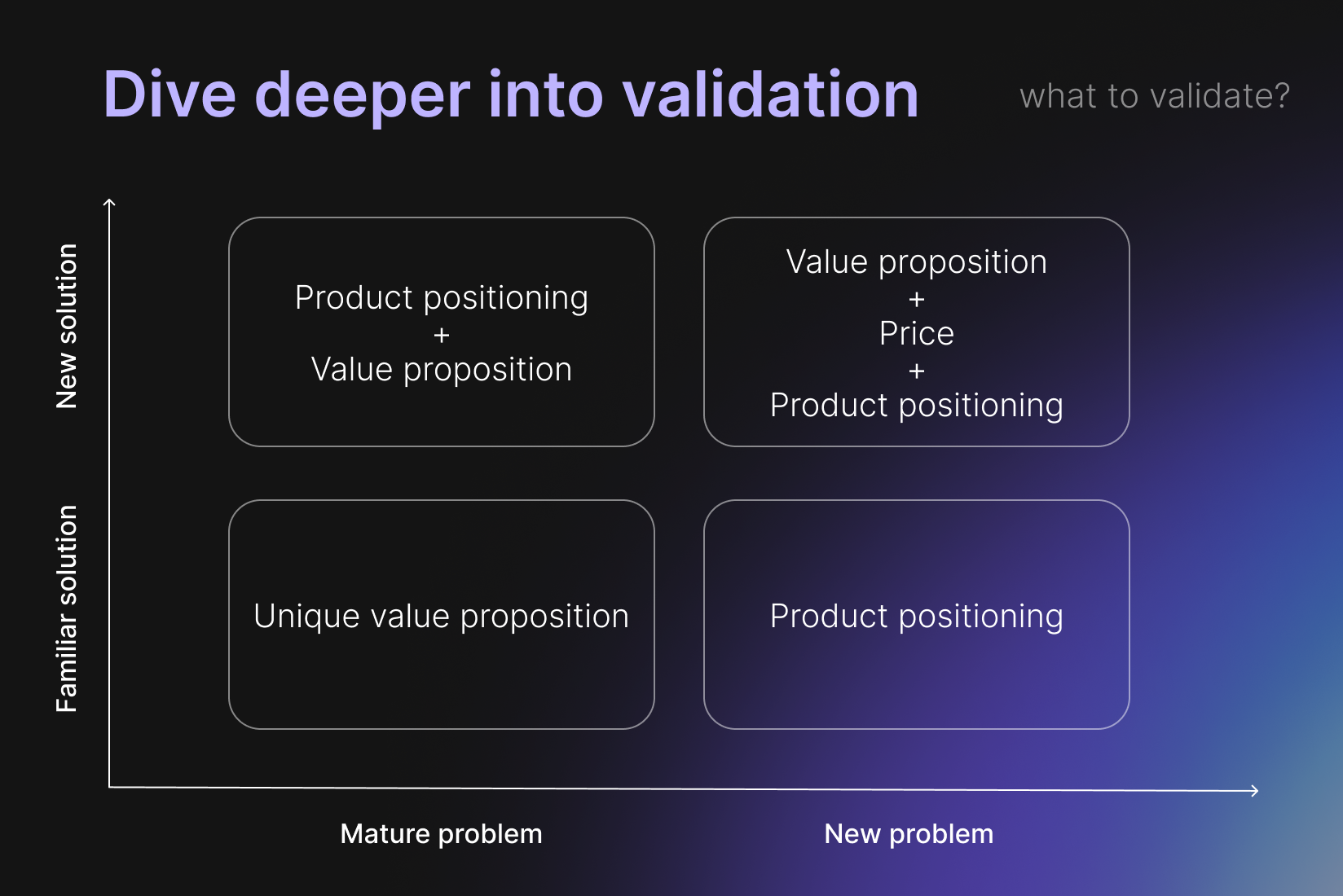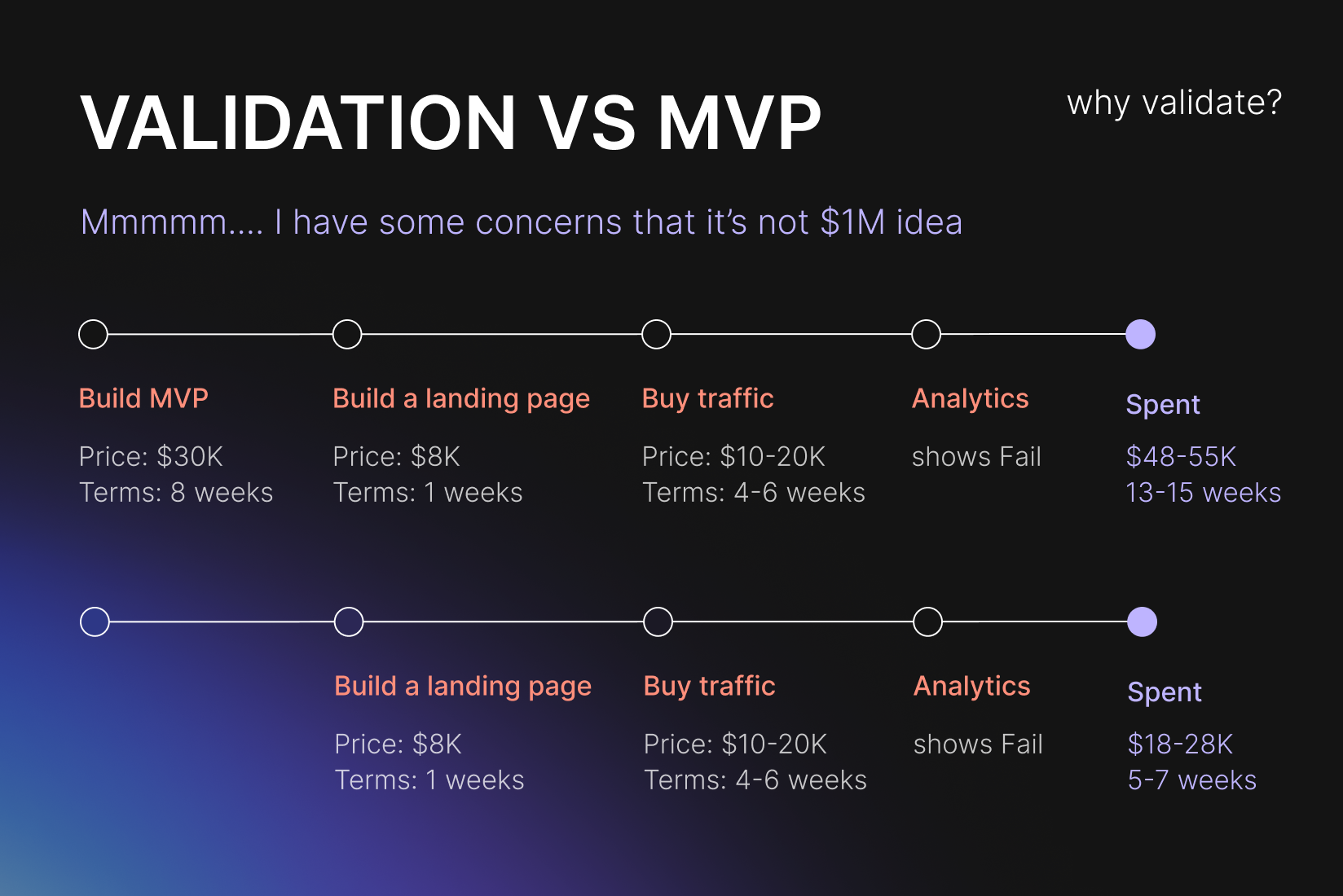Why validate? The truth behind building startups
A lot of founders decide to build their product right away, without validating the idea or product first. Is it always a good idea? Is validation valuable or not?

In this article, Alena Timofeeva explores when and why the founder should pay $50k for validation of the product instead of building the MVP for the same $50k.
Choose your validation type
There are two types of validation:
- Need/Problem validation: when you validate if there is a problem on the market that needs to be solved with some new product or in a new way;
- Solution/Product validation: when the problem exists but you’re not sure that your product can help to solve it in a way customers need.
In our experience, founders seem more eager to validate problems than solutions. Each type has a slightly different approach.
Find out how you’re going to validate
Need/Problem concept testing
To validate the need or problem, it’s common to:
- Initiate Customer Development (cust-dev).
- Research comments on forums.
- Search for feedback in open sources.
To do cust-dev it’s important to find your target audience and gather for feedback from them. This is the most reliable source of information to validate the problem but is also the most time-consuming one.
Of course, you can also search the comments on forums like Quora or Reddit, but it will be less credible as the audience may be not entirely right. The same goes for the feedback from open sources.
Solution/Product concept testing
To validate the solution or product, it’s common to:
- Research the competitors.
- Initiate customer development.
- Bring traffic to look at the results.
If you’re looking at your competitors you need to keep in mind their number, do they cover all the needs of the customers, what feedback they have, etc. You can also validate the solution with the help of cust-dev, but it’s even more valuable to bring traffic to your landing page or page on the app market to see if your solution is capable of converting your target audience.
Find how accurate your validation is
All the time during the validation process you need to focus on reducing the risks of startup failure due to “there is no product-market fit.”
And you can get a clear answer to that question by seeing the readiness of the audience to pay for your product.
With this focus in mind, we decided to validate all products that come to Paralect with the help of traffic.
Validate depending on the problem and solution novelty and familiarity
If you want to dive deeper into the validation process with the help of traffic, you’ll need to keep in mind more details. Take a look at the problem-solution matrix below.

Validate depending on the maturity of the problem and the familiarity of the market and your audience with a solution you suggest to them.
- A mature problem with a familiar solution: There are many options to solve the problem, and it’s well known to the market. Your only way to stand out from competitors is to find a unique value proposition.
For example, GetSphere took the well-known problem of people wanting to grow and learn, dive deeper into some industries, and increase their qualifications. Their unique value proposition was to make small cohorts of learners (not individual lessons, but not large groups also) and give them super concentrated knowledge from the most trusted and reliable speakers in the domain. It gave the audience a chance to learn not only from their cases but from the experiences of other people in the process.
- The problem is new, but the solution is familiar: The audience solved another issue with such an approach — you need to focus more on your positioning. This way your customers will understand that they will be able to solve their problems with instruments they’ve tried before.
- The problem is mature, but the solution is new: You need to focus on your product positioning and your value proposition. Why does the problem need to be solved in a new way? Is it cheaper? Faster? More convenient?
Darsel was going exactly this way. The problem was familiar to the market. The edTech industry faces a lot of limitations when it comes to the speed of the Internet. For some audiences, it was hard to learn while loading high-res videos. So Darsel converted all the videos into text formats.
- Both the problem and the solution are new: You need to be cautious. It’s easy to create something that is already on the market. Still, new niches are opening. For example, the pandemic times created a need for corporate automatization. As everybody went remote the demand for security has also increased. For this validation, you need to test everything: value proposition, product positioning, and pricing.
Imagine you’re validating Mailchimp. You need to look at the pricing model and test various subscription options, packaged deals, and overall pricing. You can do it all with the help of A/B testing. Just look at the price sensitivity and experiment.
Validate… or not?
Let’s return to our initial question — to validate or to build an MVP with all the knowledge from above. Does validation seem reasonable?
Well, if you are:
- 100% sure that your product has no competitors or you won’t need to lure the customers from them, or
- 100% certain that the problem exists and your solution is understandable and convenient.
Congrats! You can start building your MVP without any validation. Still, in reality, all these certainties are conditional on the level of personal fantasies.

Look at the roadmaps above. Imagine you started with MVP, built a landing page, and brought traffic. While looking at the analytics you realized one of the possible scenarios — you’ve failed. While validating the product, you can get the same results without spending money on building the actual solution.
If you’re not sure that your idea or product is valuable enough, you can spend twice the money and time to develop an MVP that nobody needs.
You will still need to attract users and bring traffic, and you still need to create ad campaigns, but at least with validation, you can cut out the product creation expenses.”
Why validate
There are three general outcomes of the validation:
- Positive: When validation proves your idea a success.
- Neutral: When validation shows interest in some parts of the product, but the idea needs a new focus.
- Negative: When there is no product-market fit.
Still, finding whether the product is a market fit is not the only valuable outcome of the validation. By validating you will:
- Find the best traffic channel for your product: Depending on the channel’s capacity and the costs of attracting the audience, you’ll be able to see where to put your budget to get cheaper leads.
- Understand costs per lead: Start calculating unit economics with this data.
- Find the most suitable value proposition: By testing several hypotheses and searching for the hooks for the target audience to attract them to the landing page and convert their actions into sales.
- Build a waiting list to attract more users and guide their expectations: You can even make the audience less disappointed in case the product turns out to be different or they will need to wait longer. Discounts for the registered users who need to wait for more for the actual launch and “book a demo” buttons may work as a magic pill to narrow the gap between reality and expectations.
This info will certainly inform your go-to-market strategy when the product is built and ready to launch!
How to validate
There is no estimated price when we’re talking about the validation. Each validation process requires a custom budget calculation because different channels have different prices for traffic acquisition. Different themes and topics on the same channel can vary in terms of competition and prices too. Such things lead to extra money needed to test hypotheses.
It’s important to validate at least 3 or more hypotheses for each product. It’s common for more hypotheses to form during validation and depending on the audience reactions.”
The common practice is to work in small iterations — validate some hypotheses and then polish them based on feedback.
When the hypotheses are ready, you need to work with the estimation. Go to the different channels, and look where your target audience is. In some cases, you can find the actual cost of the lead for your audience, but for some channels like Twitter or Meta, it will only be a benchmark based on someone's previous experience. Use this data to estimate the costs of the lead, conversion rate, and target actions on your website such as “Buy now” or “Book a demo”.
Remember that no matter who is helping you with a validation process, you can’t reduce the price much. Most of the validation budget is calculated from the fees for ads that will go to the ads channels. The channel is forming the price, not the team that is validating the product or idea.
Metrics that are important to look at during validation:
- CTR
- Heat map
- Session duration
- Conversion into a target action
Such a set of metrics helps to understand users’ reactions to the different stages of interactions with your product. All these metrics help to validate the solution and see how the website and ads are performing.
To make the most out of the metrics, connect them to some goal, e.g. 50 registrations to “Book a demo” during the validation period. If you see after some time that the goal cannot be reached or the cost of the lead is way higher than the estimation was, it’s better to stop right away — even if the validation process (4-6 weeks) is still on-going.
These results show that the market reaction is different from what we expected and we need to correct our course of action before proceeding further.
Bottom line
Validating your idea or product before building the actual MVP can save you time and money. It will also help you find a better product-market fit and the best channel to attract more people from your target audience.
If you’re not sure that your idea or solution is valuable (or at least you don’t have data to support your claim), it’s better to validate first.




